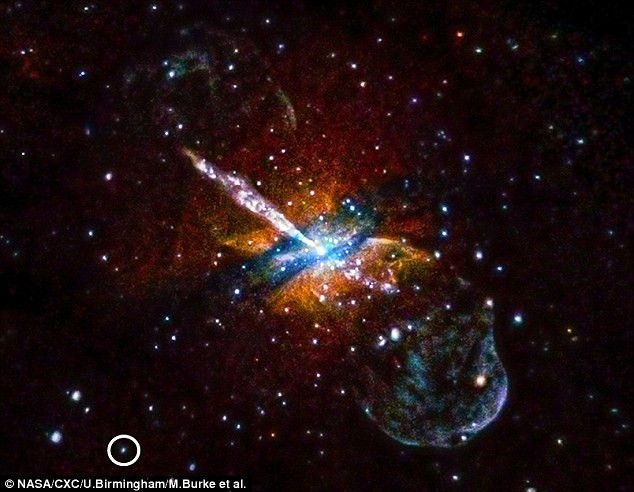Two difficult sources of X-rays illuminate near the Milky Way
American astronomers discovered from the data stored two mysterious light sources flashed a total of 6 times and lasted for a minute before dissolving.
A group of astronomers led by Jimmy Irwin of the University of Alabama, USA, found two sources of bright X-rays at the edges of the two nearby galaxies: Virgo (NGC 4636) and Centaurus A (NGC 5128). The research results are published yesterday in the journal Nature, according to the International Business Times.
Previously, scientists discovered two flashes of X-rays in a very short time with strong brightness near the galaxy NGC 4697 . Irwin and his colleagues decided to look for similar flashes of light by examining the observations of the 70 galaxies near the Milky Way of the Chandra X-ray observatory.

X-ray source (circled) near galaxy NGC 5128. (Photo: NASA).
The team identified two more light sources. A source flashed once while the other source flashed five times. Each flash of light lasted less than a minute and faded in about an hour. Light rays emit brighter than every neutron star. In particular, the light source seems to lie between the long-standing objects.
Typically, light sources can be identified through consideration of the glow time and the number of repetitions. The light does not repeat and lasts about a minute often signals the death of a giant star. But the light source must be in the young star population. Repeated rays also appear only under certain conditions that the team did not find in the strange X-ray source just discovered.
The researchers identified that X-ray sources could be a black hole undergoing some movement. "The first possibility, as the authors put it, is that there is a medium mass black hole (100-1000 times the mass of the Sun) in the center of each light source. For some reason, they emit X-rays in about an hour, another possibility is that a low-mass black hole directs X-rays to Earth, a binary star system with unpredictable orbits that can lead to repeated light rays from nearby sources. NGC 5128, " said Sergio Campana, a researcher at the Italian Institute of Astrophysics.
Campana also stressed that more observations should be made to explain X-rays, especially their repetition frequency.
- The Milky Way's black hole may have erupted a giant air bubble
- Enjoy the pure Milky Way season
- Element acceleration in the Milky Way galaxy
- The mysterious bubble appears between the Milky Way
- Fun little-known facts about the Milky Way
- The mass of the Milky Way
- The Milky Way had 'devoured' another galaxy billions of years ago
- Gamma rays are difficult to explain in the universe
- The Milky Way might contain 100 million black holes
- The Milky Way has died once, we live in its second
- Super black holes bombard the Earth with powerful cosmic rays
- Decoding the mysterious ray of Dr. Vu Van Bang
 Van Allen's belt and evidence that the Apollo 11 mission to the Moon was myth
Van Allen's belt and evidence that the Apollo 11 mission to the Moon was myth The levels of civilization in the universe (Kardashev scale)
The levels of civilization in the universe (Kardashev scale) Today Mars, the sun and the Earth are aligned
Today Mars, the sun and the Earth are aligned The Amazon owner announced a secret plan to build a space base for thousands of people
The Amazon owner announced a secret plan to build a space base for thousands of people